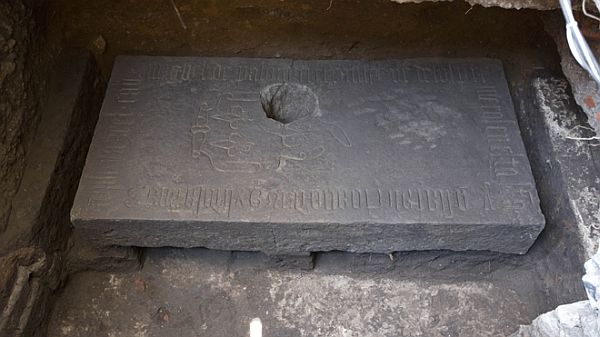Mexico City - Archaeologists have found a massive stone slab covering the tomb of one of the first Catholic priests in Mexico following the 1521 Spanish conquest, a grave sunk into the floor of what appears to be an Aztec temple.
The discovery suggests the extent to which the Spanish re-used the temples of the Aztec capital in the first years after capturing it. The huge slab was uncovered in recent days at the site of the now-disappeared first cathedral of Mexico City, built in 1524 yards from the current cathedral that replaced it in the 1620s.
The nearly 2-meter-long slab was sunk into the same level of the stucco floor of what appears to be an Aztec temple. The cathedral was simply built over the temple and apparently used the same floor. The Spaniards apparently gave the floor only a thin coat of lime white-wash before using it for their church.
"The Spaniards, Hernán Cortés and his followers, made use of the pre-Hispanic structures, the temples, the foundations, the floors," said Raúl Barrera, an archaeologist for the government's National Institute of Anthropology and History. "They even used the walls, the floors. They couldn't destroy everything all at once."
The name of priest Miguel de Palomares was found carved on the slab. Archaeologists must still confirm it his burial place, and hope to find his remains when they lift the stone slab in the coming weeks. De Palomares was a prominent priest who died in 1542 and was buried inside the old cathedral, apparently near an altar.
Barrera said stones near one end of the slab appear to be part of that altar.
Within 30 years after his burial, the first cathedral was already deemed too small and in bad shape to serve the thriving new colony. The second cathedral was built next to it between 1573 and the 1620s, when the old cathedral was torn down and, apparently, quickly forgotten.
At some time before Mexico gained its independence in 1821, someone drilled a hole into the ground where the tomb stands and sank a wooden post or a cross into the tomb. The capstone slab bears a hole where the post stood and the stone is fractured into two parts, perhaps as a result.
Archaeologists have long known the Spaniards often appeared to prefer to build their churches atop Aztec temples, but it was thought that was for symbolic purposes, to signal the displacement of old Aztec gods by the Christian church. But it may also have been a practical decision, as the pre-Hispanic temples had good foundations, walls and floors that the Spaniards could use, saving them the trouble of building new ones.
The grave slab was found by accident, when engineers were trying to dig foundations for lamp posts to illuminate the current cathedral.
Original article


